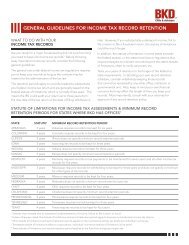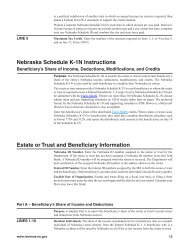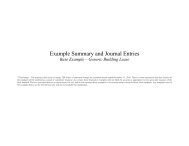acfe fraud prevention check-up - BKD
acfe fraud prevention check-up - BKD
acfe fraud prevention check-up - BKD
- No tags were found...
You also want an ePaper? Increase the reach of your titles
YUMPU automatically turns print PDFs into web optimized ePapers that Google loves.
Fraud risk identification may include gathering external information from regulatory bodies (e.g., securitiescommissions), industry sources (e.g., law societies), key guidance setting gro<strong>up</strong>s (e.g., Cadbury, King Report 7 , and TheCommittee of Sponsoring Organizations of the Treadway Commission (COSO)), and professional organizations (e.g.,The Institute of Internal Auditors (IIA), the American Institute of Certified Public Accountants (AICPA), the Associationof Certified Fraud Examiners (ACFE), the Canadian Institute of Chartered Accountants (CICA), The CICA Alliance forExcellence in Investigative and Forensic Accounting, The Association of Certified Chartered Accountants (ACCA),and the International Federation of Accountants (IFAC), plus others noted in Appendix A of this document). Internalsources for identifying <strong>fraud</strong> risks should include interviews and brainstorming with personnel representing a broadspectrum of activities within the organization, review of whistleblower complaints, and analytical procedures.An effective <strong>fraud</strong> risk identification process includes an assessment of the incentives, pressures, and opportunitiesto commit <strong>fraud</strong>. Employee incentive programs and the metrics on which they are based can provide a map to where<strong>fraud</strong> is most likely to occur. Fraud risk assessment should consider the potential override of controls by managementas well as areas where controls are weak or there is a lack of segregation of duties.The speed, functionality, and accessibility that created the enormous benefits of the information age have alsoincreased an organization’s exposure to <strong>fraud</strong>. Therefore, any <strong>fraud</strong> risk assessment should consider access andoverride of system controls as well as internal and external threats to data integrity, system security, and theft offinancial and sensitive business information.Assessing the likelihood and significance of each potential <strong>fraud</strong> risk is a subjective process that should consider notonly monetary significance, but also significance to an organization’s financial reporting, operations, and reputation,as well as legal and regulatory compliance requirements. An initial assessment of <strong>fraud</strong> risk should consider theinherent risk 8 of a particular <strong>fraud</strong> in the absence of any known controls that may address the risk.Individual organizations will have different risk tolerances. Fraud risks can be addressed by establishing practicesand controls to mitigate the risk, accepting the risk — but monitoring actual exposure — or designing ongoing orspecific <strong>fraud</strong> evaluation procedures to deal with individual <strong>fraud</strong> risks. An organization should strive for a structuredapproach versus a haphazard approach. The benefit an implemented <strong>fraud</strong> risk management program providesshould exceed its cost. Management and board members should ensure the organization has the appropriate controlmix in place, recognizing their oversight duties and responsibilities in terms of the organization’s sustainabilityand their role as fiduciaries to stakeholders, depending on organizational form. Management is responsible fordeveloping and executing mitigating controls to address <strong>fraud</strong> risks while ensuring controls are executed efficientlyby competent and objective individuals.Fraud Prevention and DetectionFraud <strong>prevention</strong> and detection are related, but are not the same concepts. Prevention encompasses policies,procedures, training, and communication that stop <strong>fraud</strong> from occurring, whereas, detection focuses on activitiesand techniques that promptly recognize timely whether <strong>fraud</strong> has occurred or is occurring.7The Cadbury Report refers to The Report of the Committee on the Financial Aspects of Corporate Governance, issued by the UnitedKingdom on Dec. 10, 1992 and the King Report refers to the King Report on Corporate Governance for South Africa, issued in 1994.8Inherent risk is the risk before considering any internal controls in place to mitigate such risk.8









